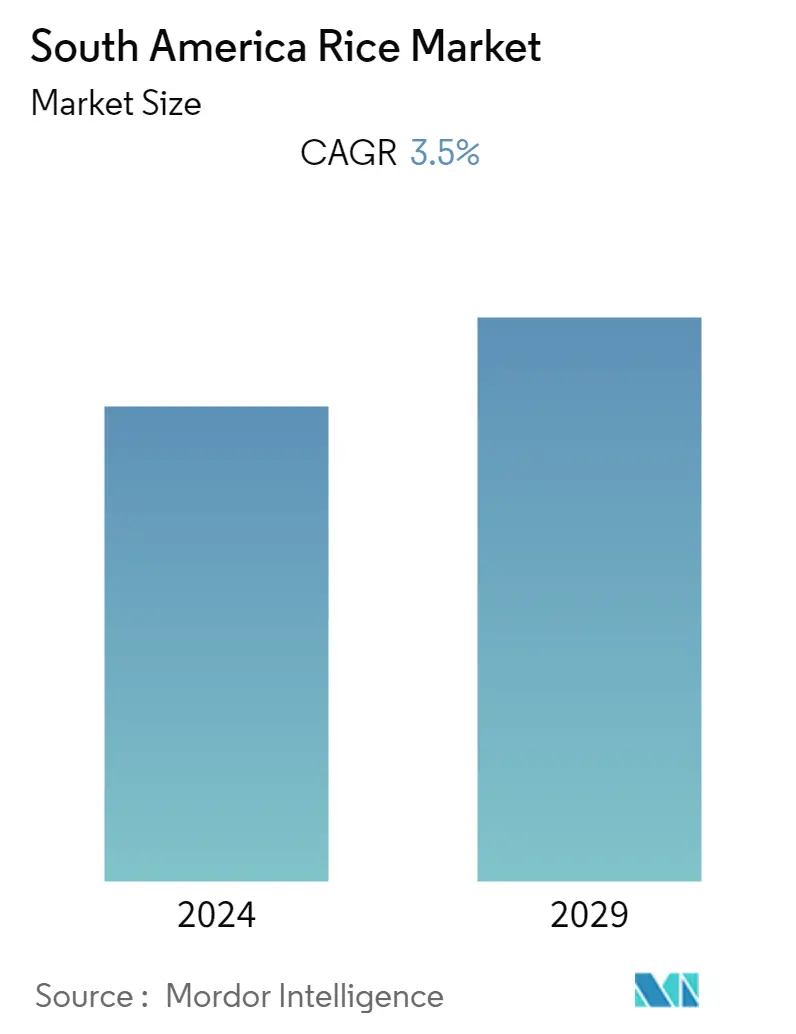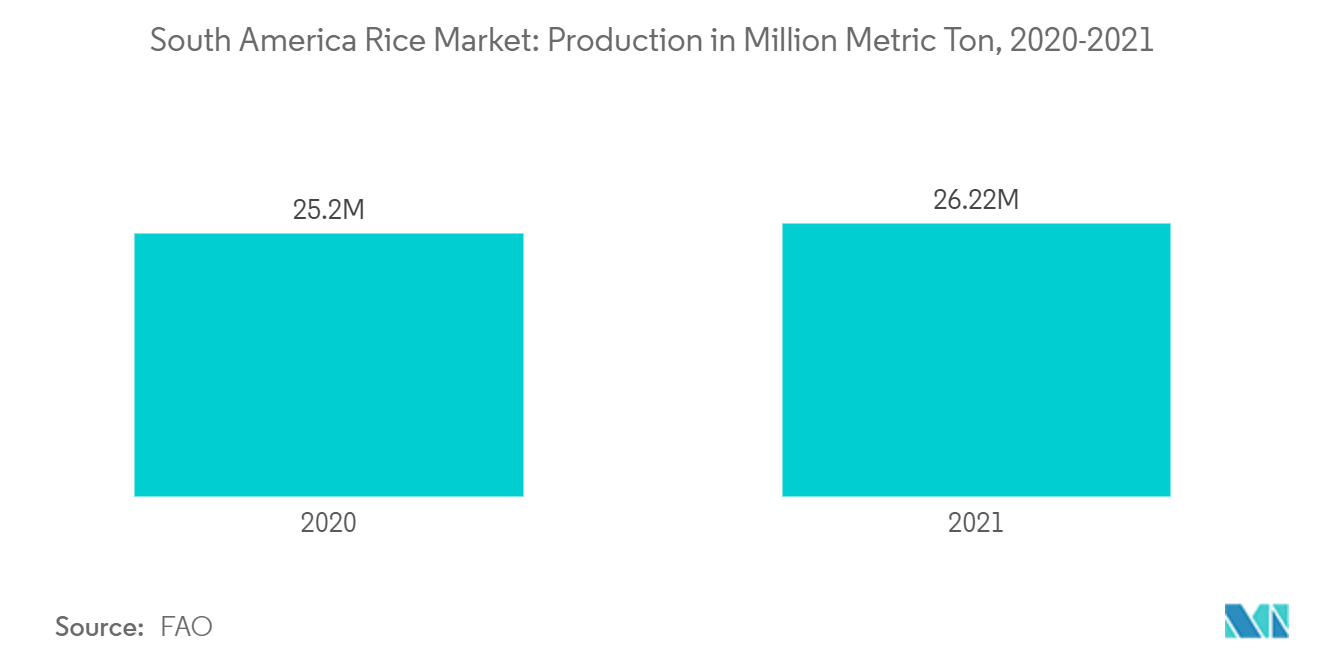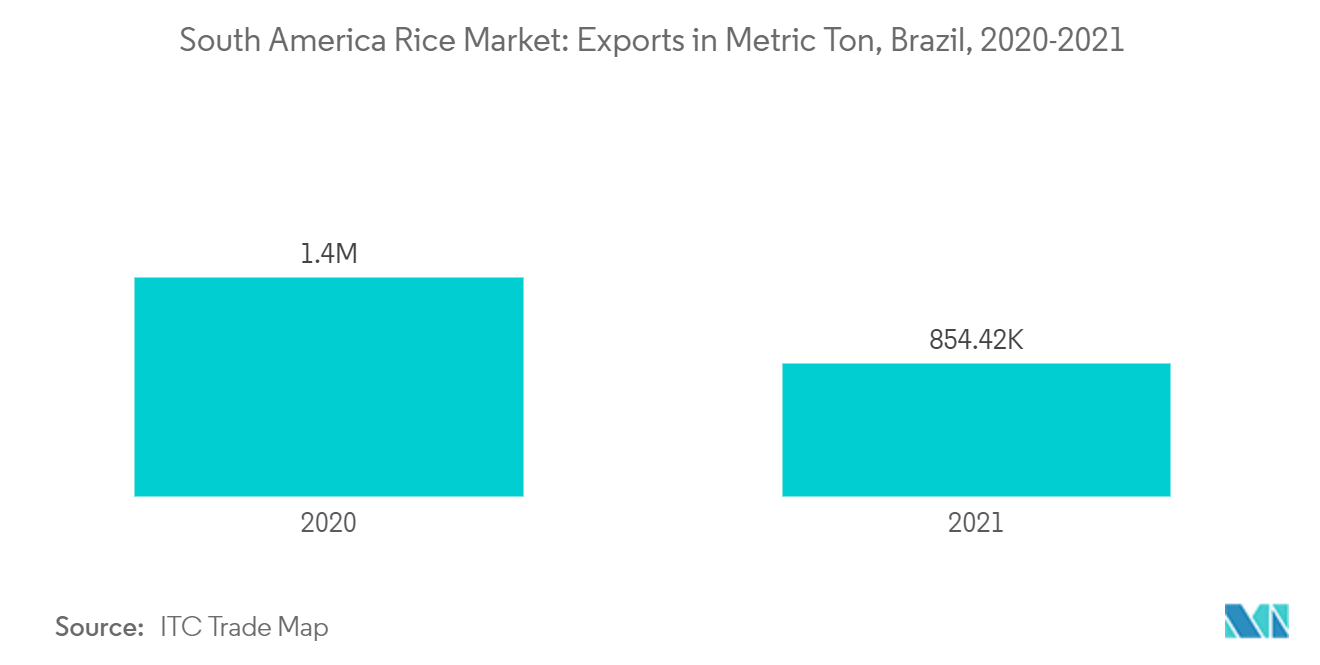South America Rice Market Size

| Study Period | 2019 - 2029 |
| Base Year For Estimation | 2023 |
| Forecast Data Period | 2024 - 2029 |
| Historical Data Period | 2019 - 2022 |
| CAGR | 3.50 % |
Major Players*Disclaimer: Major Players sorted in no particular order |
South America Rice Market Analysis
The South America rice market is estimated to record a CAGR of 3.5% during the forecast period.
- Rice is grown as a major staple crop in most countries of South America. The crop is cultivated in wet soils common in the lowlands of the region. The lowland rice expansion in the vast wetlands of Brazil (with a potential of 24 million hectares), the Andean countries (Bolivia, Ecuador, Peru, and Venezuela), and the River Plate Basin (Argentina, Paraguay, and Uruguay) would greatly influence the regional production of rice in the future. The tropical countries of the region account for the majority of demand.
- The Russia-Ukraine war had a negligible impact on the rice market because rice is not a staple in Russia and Ukraine. Therefore, there is no proportional price spike due to the invasion. However, the same is not the case for the price of other grains. The United Nations Food and Agriculture Organization's (UN-FAO) price index for cereal grains jumped 17.1% between February and March 2021, while the price index for rice remained stagnant, 10% lower than it was a year ago.
- Rice consumption is income elastic in the region, as consumers tend to increase consumption as their incomes rise. The yield in the region was 63,857 hg/ha in 2021, which increased compared to the previous year. Direct seeding and purchased inputs are used for cultivation across the region. Uruguay has gained the third-highest rice productivity in the world, with an average of 8 metric tons per hectare of dry paddy rice in the last 5 years. These factors are boosting the growth of the rice market in the region.
- Factors driving Brazil's transformation include agricultural research that has increased yields, expansion of the arable land base, significant investments in production technologies to develop crop and forage varieties, and increased global demand for food and animal feed, particularly over the last decade. These are anticipated to grow the market during the forecasting period.
South America Rice Market Trends
This section covers the major market trends shaping the South America Rice Market according to our research experts:
Rice Production is witnessed to be higher in the Region
- Rice production in South America is focused on tropical countries of the region, with Brazil being the largest producer of grain, followed by Peru, Colombia, and Ecuador. Despite the region's ability to produce rice, Latin America is also a net importer of rice, like Africa. With rice consumption rising in the region by as much as 40% over the last two decades, rice is becoming the fastest-growing staple food in the region. According to Food and Agriculture Organization Corporate Statistical (FAOSTAT) database, rice production in the region increased to 26 million metric tons in 2021 compared to the previous year's production of 25 million metric tons in 2020.
- Rice is a leading protein source for the poorest of the tropical population, accounting for 25% of the South American region. Therefore, these reasons have triggered the increasingly efficient rice production in the region with the adoption of modern varieties that are more resistant to climate change. Furthermore, as per Food and Agriculture Organization (FAO) data, the area harvested for rice was 4,105,452 hectares in 2021, a slight decrease compared to the previous year, 2020, with 4,129,302 hectares. This was due to the pandemic in the region.
- According to the Food and Agriculture Organization Corporate Statistical (FAOSTAT) Database, in 2021, among the South American countries, Brazil was the leading rice producer with 11.6 million metric tons, followed by Peru and Colombia with the production of 4 million metric tons and 3.3 million metric tons, respectively. In Brazil, Peru, Colombia, Argentina, and Uruguay, rice is the majorly consumed crop, providing 20% more calories than any other crop. This is expected to boost the market in the coming years.

Brazil Dominates the Export in Terms of Volume in South America
- Brazil, the fifth largest country in area and population and the largest in terms of arable land, is among the few countries with the potential to increase agricultural productivity. Over the past two decades, Brazil has consolidated its position as a major producer of agricultural commodities and related food products and a supplier to international markets. These factors will increase the market growth in the coming years.
- In South America, Brazil, Uruguay, Paraguay, and Argentina are the major exporters of rice, among which Brazil is the largest producer and exporter. As per the International Trade Center (ITC) Trade Map, the export of rice from Brazil witnessed a growth of about 100% during 2018-2021. In the past five years, Brazil exported rice worth USD 467,911 thousand from 2018 to USD 359,090 thousand in 2021 to countries like Venezuela, Peru, Senegal, the United States, Mexico, and more. However, in 2021, the export value declined due to the COVID-19 pandemic.
- In 2020, Venezuela accounted for 14.3% share, and Peru for 15.9% of the total Brazil exports. Further, with the continental proportions and the cutting-edge technology employed in industrial processes, the country is quickly able to expand its offer of grain in the face of global demand. This may boost Brazil's exports and, in turn, may drive the South American rice market during the forecast period.

South America Rice Market News
- January 2023: According to the Brazilian Rice Industry Association (Abiarroz), Brazil increased rice exports in 2022 by 2.1 million tons, almost an 85% increase over the volume exported in 2021.
- October 2022: Brazil partnered with Mercosur to become a global rice exporting hub. As India restricted rice shipments, Brazil signaled at the World Trade Organization (WTO) that together with Mercosur partners, it is ready to expand exports and help with global food security. According to the Brazilian Rice Industry Association (Abiarroz) Brazil exports up to 1.5 million tons of cereal a year and can add another 2.5 million tons, including stocks from neighboring Mercosur countries.
South America Rice Market Report - Table of Contents
1. INTRODUCTION
- 1.1 Study Assumptions & Market Definitions
- 1.2 Scope of the Study
2. RESEARCH METHODOLOGY
3. EXECUTIVE SUMMARY
4. MARKET DYNAMICS
- 4.1 Market Overview
- 4.2 Market Drivers
- 4.3 Market Restraints
- 4.4 Value Chain Analysis
5. MARKET SEGMENTATION
-
5.1 Geography (Production Analysis (Volume), Consumption Analysis (Value & Volume), Import Analysis (Value & Volume), Export Analysis (Value & Volume) and Price Trend Analysis)
- 5.1.1 Brazil
- 5.1.2 Argentina
- 5.1.3 Chile
- 5.1.4 Peru
- 5.1.5 Rest of South America
6. MARKET OPPORTUNITIES AND FUTURE TRENDS
** Subject To AvailablitySouth America Rice Industry Segmentation
Rice is the starchy seeds or grain of annual marsh grass, Oryza sativa, cultivated in warm climates and used for food. It is cultivated as the major staple crop and has economic importance in the region.
The South American rice market is segmented by geography into Brazil, Argentina, Uruguay, Chile, Peru, and the Rest of South America. The report includes production analysis (volume), consumption analysis (value and volume), export analysis (value and volume), import analysis (value and volume), and price trend analysis.
The report offers the market size and forecast in both value (USD million) and volume (metric ton).
| Geography (Production Analysis (Volume), Consumption Analysis (Value & Volume), Import Analysis (Value & Volume), Export Analysis (Value & Volume) and Price Trend Analysis) | Brazil |
| Argentina | |
| Chile | |
| Peru | |
| Rest of South America |
South America Rice Market Research FAQs
What is the current South America Rice Market size?
The South America Rice Market is projected to register a CAGR of 3.5% during the forecast period (2024-2029)
What years does this South America Rice Market cover?
The report covers the South America Rice Market historical market size for years: 2019, 2020, 2021, 2022 and 2023. The report also forecasts the South America Rice Market size for years: 2024, 2025, 2026, 2027, 2028 and 2029.
South America Rice Industry Report
Statistics for the 2024 South America Rice market share, size and revenue growth rate, created by Mordor Intelligence™ Industry Reports. South America Rice analysis includes a market forecast outlook 2029 and historical overview. Get a sample of this industry analysis as a free report PDF download.



